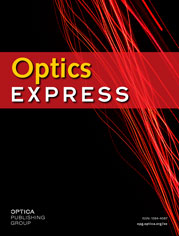Optics Express Focus Issue
Quantum Cascade Lasers (Invited Only)
Submission Open: 1 November 2014
Submission Deadline: 4 December 2014
This Focus Issue will be based on research presented at the International Quantum Cascade Laser School and Workshop 2014 (IQCLSW 2014) (www.iqclsw2014.cnr.it), held in Policoro (MT), Italy from 7 September to 12 September 2014. The International Quantum Cascade Laser School and Workshop 2014 aims to be a think-tank where top researchers in the field will report on recent exciting developments and brainstorm on promising new directions ranging from questions of basic device physics to applications.
The Guest Editors will select the top-ranked conference participants and solicit them to submit to this Focus issue. These papers will present original, previously unpublished work, and will undergo the same rigorous peer review as any other paper under consideration for the journal. Normal Optics Express open access charges will apply to all published articles.
QCLs are unipolar devices exploiting optical transitions between engineered electronic states (conduction subbands) created by spatial confinement in semiconductor multi-quantum-wells. The extreme precision of the material growth, necessary to obtain the peculiar characteristics required by the device design, together with the large number of layers and the complexity of the structure, makes this laser the most impressive demonstration of the capabilities offered by bandgap engineering.
After 20 years from their invention, QCLs have reached outstanding performance levels from the mid-IR to the far-infrared spectral ranges. Multi-watt output power, continuous wave, room-temperature devices, with wall-plug efficiencies larger than 50%, actually makes the QCL technology the most efficient one across the mid-IR (4.3-24 µm). At the same time, despite the still low operating temperatures (≤ 199.5 K), THz QCLs gained a realistic chance to deeply impact technological applications, thanks to the high output power (≈ 1W), the quite broad operating frequency range (1.2-4.7 THz), the unmatched compactness and the possibility to engineer the output beam direction via novel plasmonic collimator approaches, as well as to stabilize their frequency, phase and amplitude.
QCLs, already commercialized by several key international companies, are now the core photonic component for a large variety of applications spanning from optical chemical sensing in various fields such as security (explosive and narcotics), medical (breath analysis and glucoses monitoring), or environmental to process and quality control, biomedical diagnostic, cultural heritage and telecommunications.
In their 20th year anniversary the workshop will address both the fundamental physics aspect of these devices as well as new outstanding scientific, technological and commercial developments. Top researchers in the field will report on recent exciting advances providing a roadmap for future challenging developments of the powerful QCL technology.
Topics to be covered by the feature issue include:
- Device physics and modeling
- Material systems
- High power / high efficiency
- Tunability
- Terahertz emission
- Short wavelength
- Interband Cascade Lasers
- Linewidth stability and frequency noise
- Microcavities, waveguides, novel resonators
- Beam shaping and beam steering
- Ultra short pulse QCL (mode locking)
- Multi-wavelength QCL (broadband devices)
- Non-linear effects
- Novel systems and phenomena
- Applications: imaging, sensing, metrology
Manuscripts must be prepared according to the usual standards for submission to Optics Express and must be uploaded through OSAs electronic-submission system (/oe/journal/oe/author.cfm).
When submitting, please specify that the manuscript is for the Quantum Cascade Lasers feature issue (choose from the drop-down menu).
Focus Issue Editors:
Miriam Serena Vitiello, Consiglio Nazionale delle Ricerche (Italy) (Lead)
Giacomo Scalari, ETH Zurich (Switzerland)
Benjamin Williams, University of California at Los Angeles (UCLA)
Paolo De Natale, Istituto Nazionale di Ottica—CNR, Italy

